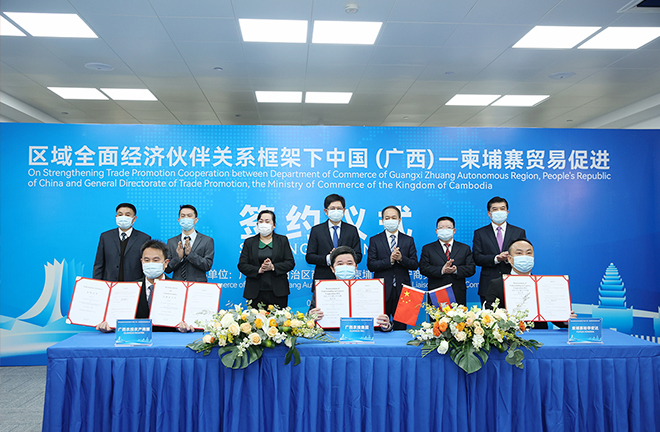RCEP boosts post-pandemic world economic recovery

Cambodia and China’s Guangxi Zhuang Autonomous Region sign a memorandum under the RCEP framework in Nanning, Guangxi, on Feb. 24. Photo: Lin Hao/CNS/CFP
Chinese President Xi Jinping delivered a keynote speech via video at the opening ceremony of the Boao Forum for Asia Annual Conference 2022 on April 21.
Xi pointed out that the entry into force of the Regional Comprehensive Economic Partnership (RCEP) and the opening to traffic of the China-Laos railway have effectively boosted institutional and physical connectivity in our region. We should seize these opportunities to foster a more open Asia-wide market and make new strides in mutually beneficial cooperation.
Entering into force on January 1, 2022, the RCEP includes 15 member states: China, Japan, South Korea, Australia, New Zealand, and the ten members of the Association of Southeast Asian Nations (ASEAN). This marked the official launch of a free trade area covering the world’s largest population, biggest economic and trade volume, and the greatest development potential. The British newspaper The Guardian called RCEP the first major international event of the year.
Considerable economic benefit
Bunn Nagara, a senior fellow from the Institute of Strategic and International Studies in Malaysia, noted that RCEP was originally proposed by ASEAN to help the economic development of East Asia, Northeast Asia, Southeast Asia, South Asia, Oceania, and other neighboring regions. In time, it will also benefit economies all around the world by increasing trade and encouraging freer trade. International trade will benefit first, then investment, and then connectivity as more goods, services, and people travel frequently with the emergence of more business partners and joint ventures.
Rajiv Biswas, Asia-Pacific chief economist at the think tank IHS Markit, added that the scope of RCEP includes reducing tariffs on trade in goods, creating higher-quality rules for trade in services, and providing market access for service sector suppliers from RCEP countries.
Since the agreement took effect, tariff reductions and preferential policies have significantly lowered the transaction cost of trade within the covered region, which brings substantial economic benefit for markets of RCEP member countries and general consumers. Upon the first day it entered into force, the proportion of zero-tariff trade between China, ASEAN, Australia, and New Zealand immediately exceeded 65%. In addition, more than 90% of trade in goods among RCEP member countries will be tariff-free in the future.
The trade cost reduction brought by RCEP is not limited to lowering tariff barriers. As Biswas further elaborated, RCEP also eliminates non-tariff barriers. Rules are stipulated in the RCEP agreement about customs and quarantine procedures, technical standards, as well as other fees, charges, and formalities connected with import and export. The agreement includes such chapters as: rules of origin, sanitary and phytosanitary measures, trade remedies, temporary movement of natural persons, intellectual property, electronic commerce, and government procurement. RCEP implementation will allow trade agreement benefits to commence for those nations that have already ratified the agreement, Biswas said.
Benefiting ASEAN countries
Among all the RCEP member countries, ASEAN is an important player. Shaun Roache, chief Asia-Pacific economist at S&P Global Ratings, once said that the biggest winners of the RCEP agreement would possibly be multiple countries across Southeast Asia.
According to statistics released by China’s General Administration of Customs, from January to February this year, ASEAN was China’s second largest trading partner.
However, with the RCEP’s gradual implementation, policy benefits have added new impetus to China-ASEAN economic and trade exchanges. The import and export data from the first quarter shows that ASEAN has regained its position as China’s largest trading partner.
As Nagara explained, international trade and investment in many ASEAN countries depend on traditional business activities that were generally suppressed as a result of the pandemic. RCEP helps to promote traditional business activities, up to a point, and mitigates low growth caused by the pandemic.
“The RCEP trade deal will add a silver lining to the medium-term export outlook of the ASEAN region. Over the long-term, despite the severe recession caused by the COVID-19 pandemic, the ASEAN region is expected to continue to be one of the fastest growing regions of the world economy,” Biswas commented.
Fostering regional and global trade
In the face of growing global uncertainties, today’s Asia-Pacific countries are more eager than ever to have a stable free trade system, and RCEP’s entry into force will invigorate trade within the region and across the globe in the post-pandemic era.
According to a report by the United Nations Conference on Trade and Development, the economic size of the emerging RCEP bloc and its trade dynamism will make the region a nucleus for global trade. The report says that the trade deal involves countries generating a total of 30.5% of the world’s GDP. By comparison, other major regional trade agreements—by share of global GDP—are the United States-Mexico-Canada Agreement (28%), the European Union (17.9%), Africa’s Continental Free Trade Area (2.9%), and Mercosur (2.4%).
To Biswas, the RCEP agreement is a major step forward by Asia-Pacific governments to liberalize regional trade flows, following the implementation of both the Japan-EU Economic Partnership Agreement and the Comprehensive and Progressive Agreement for Trans-Pacific Partnership deals.
“RCEP signals a significant change of the entire Asia-Pacific trade policy landscape,” Biswas concluded.
Edited by JIANG HONG
